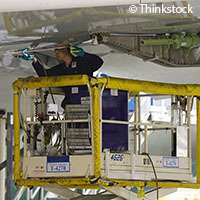Material simulation technology to boost EU aircraft industry

Accurately predicting the mechanical behaviour of composite aircraft structures on impact could reduce the need for physical tests, cut industry costs and ultimately save lives through better aircraft design. This is the focus of the EU CRASHING project, which aims to develop new methods of testing materials through multi-scale computer simulation.
Composite materials - materials made from two or more substances that when combined produce a material with new characteristics - are widely used as principal structural elements in aircraft design. Before such materials can be used however, a complete understanding of their mechanical properties is required
This R&D phase can be time consuming and prohibitively expensive. The two-year CRASHING project aims to address this by building on recent progress made in multi-scale modelling, which can solve physical problems that occur at different levels and be applied to different materials. This makes it ideal for the purposes of the aeronautics industry. CRASHING will focus on composite materials used in current aircraft design, as well as on innovative materials with potential applications in the future.
Applied to the aircraft industry, this multi-scale approach will be used to examine material behaviour at different levels, from the molecular right up to how components interact. Computer models will then be developed to provide accurate simulations of what happens when an aircraft crash-lands, is hit by ice or is exposed to other extreme impacts.
Ultimately, it is hoped that CRASHING will lead to a significant reduction in the number of physical tests required for aircraft certification, and reduce the development time of new structural components. This in turn will have a beneficial effect on the European economy; the European aerospace industry is a key high-tech sector of the EU, employing hundreds of thousands of people and generating billions of euros in turnover.
In fact, the EU has a trade surplus for aerospace products, which are exported all over the world. Ensuring European competitiveness in this field is a priority.
The CRASHING project, funded by the Clean Sky Joint Technology Initiative (JTI-Clean Sky) within the EU's 7th Framework Programme, is being led and coordinated by the IMDEA Materials Institute in Spain. IMDEA will be responsible for the development and validation of the multi-scale models at the different levels. The other partner of the consortium, the Carlos III University of Madrid, will be in charge of the experimental characterisation of materials under impact. CRASHING, which was launched in April 2014, is due to run until 2016.
Clean Sky is one of the most ambitious aeronautical research programmes to be launched in Europe. It aims to develop and encourage the commercialisation of breakthrough technologies that will lead to less noisy, safer and more fuel efficient aircraft. The Clean Sky JTI is a unique Public-Private Partnership between the Commission and industry.
Provided by CORDIS




















